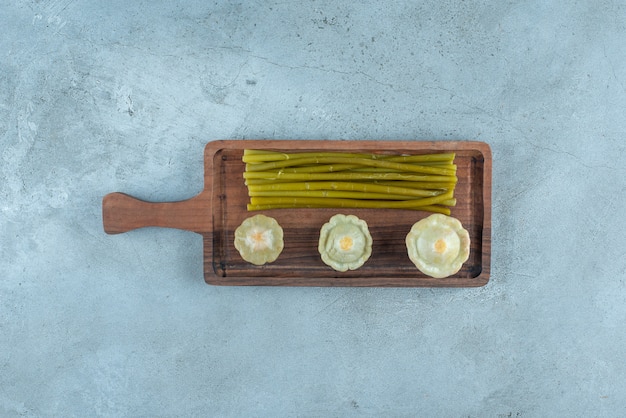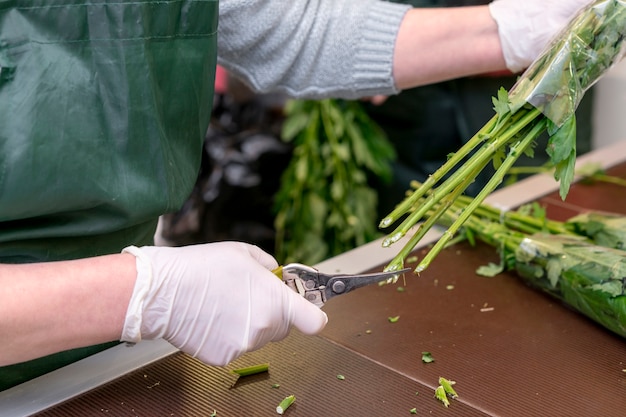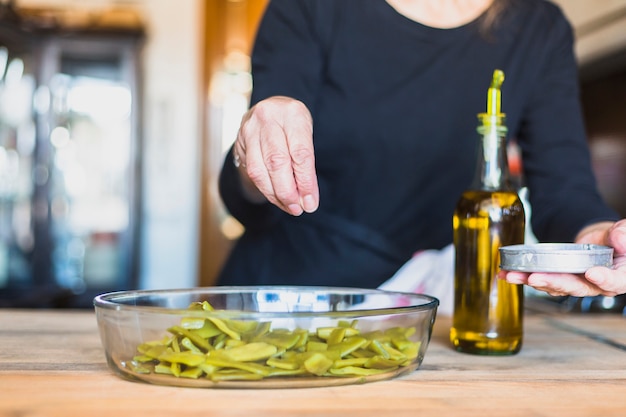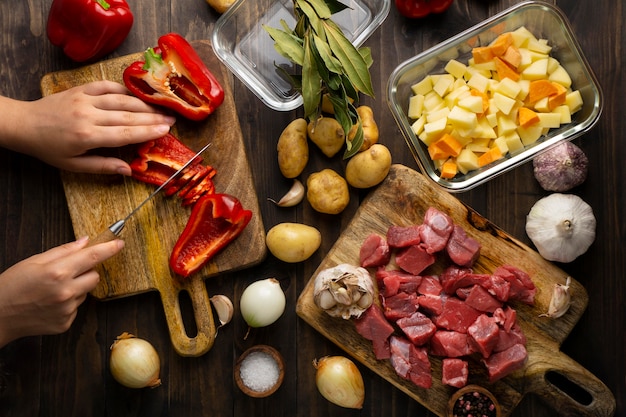Let’s face it, spring just wouldn’t be the same without asparagus. It’s the quintessential sign that warmer days are here, and with that comes the irresistible urge to get our hands on those vibrant green spears. But let’s be real, getting asparagus perfectly cooked can be a bit of a culinary tightrope walk. You want that satisfying snap, the tender texture, and the earthy, springy flavour that makes this veggie so special. I’ve been on that journey, folks, from soggy, mushy asparagus disasters to perfectly cooked triumphs, and I’m here to share my hard-earned wisdom to help you avoid those kitchen calamities.
(Part 1) The Importance of Choosing the Right Asparagus

Think of it like this, choosing the right asparagus is like picking the perfect ingredients for any recipe – it sets the stage for success. You wouldn’t use stale bread for toast, would you? Just like that, you want the freshest, most vibrant asparagus you can find. But how can you tell the good from the not-so-good? Let’s dive into those asparagus secrets!
Tip 1: Look for Tight Tips
Here’s my first rule of thumb: always go for asparagus with tight, compact tips. You know, those that haven’t been left out in the sun for too long. They’re a sure sign of freshness. Picture it – those tightly packed tips mean they’ve retained their flavour and they’re bursting with potential.
Tip 2: Avoid Wilting Stems
Give those stems a good look. You want them to be firm and springy, not limp and wilting. A little asparagus spring test is a good idea – gently bend the stem, and it should snap back. If it bends and stays bent, you’re looking at an asparagus that’s seen better days.
Tip 3: Check the Colour
The colour of asparagus can tell you a lot about its age, so don’t be shy about checking it out. Look for vibrant green spears, not those that are turning a bit yellow or brownish. Those guys have been around a bit too long and won’t be as tasty. The vibrant green tells you that this asparagus is bursting with spring flavour!
Tip 4: Don’t be Afraid to Ask
And, don’t be afraid to ask your greengrocer for advice. They're usually a great source of knowledge about fresh produce, and they’ve seen it all, right? Just pop in and say something like, “Can you recommend the best asparagus for boiling, please?” They’ll be happy to help you pick the perfect bunch and might even share some insider tips!
(Part 2) Preparing Your Asparagus for Boiling: A Simple But Crucial Step

Now that you’ve got your hands on some top-notch asparagus, it’s time to get it ready for boiling. It’s a simple process, but it’s important to get it right to make sure your asparagus comes out perfect.
Step 1: Trimming the Ends
Start by trimming the woody ends. You know, those tough, pale bits that won’t soften no matter how long you boil them. They’re basically the asparagus’s “unwanted relatives,” and they’ll ruin your culinary masterpiece. I usually snap them off with my fingers – a little bit of pressure and they should break off easily. If you're not sure, you can always cut them off with a sharp knife.
Step 2: Washing the Asparagus
Next, give your asparagus a good wash under cold water. You want to make sure any lingering dirt or grit is gone. I tend to give them a little scrub with my hands, but you can use a vegetable brush if you like. Just make sure you get all those little nooks and crannies.
Step 3: Peeling for a Smoother Texture (Optional)
This is where it gets a bit more personal. Some people swear by peeling the asparagus, especially if the stems are thick. Peeling removes the tough outer layer and allows the asparagus to cook more evenly. It’s kind of like giving your asparagus a mini spa treatment, and it can make a big difference in texture, especially for thicker stalks. I usually do it for thick stems, using a vegetable peeler, but it’s totally up to you.
(Part 3) Mastering the Boiling Process: A Step-by-Step Guide

Alright, the big moment has arrived. It’s time to boil that asparagus to perfection. You’ve got your fresh, prepped asparagus, so let’s get started!
Step 1: The Boiling Water
First things first, fill a large pot with plenty of water – enough to cover the asparagus. Then, bring the water to a rolling boil. I'm talking a serious boil here, not just a simmer. This is important to make sure the asparagus cooks evenly and quickly. Think of it like a mini spa for your asparagus, a hot bath to bring out its best qualities!
Step 2: Adding Salt to the Water: A Secret Weapon
Now, here’s a little trick I've learned. Don't just throw the asparagus into plain water. Season the boiling water with salt. It helps to flavour the asparagus and keeps it from getting too mushy. I usually use about a teaspoon of salt for every 2 litres of water, but feel free to adjust it to your taste. It’s like giving your asparagus a little flavour boost, so it’s not just blandly tender – it’s actually delicious!
Step 3: Plunging the Asparagus: A Moment of Truth
Alright, time to add the asparagus. Gently plunge your asparagus into the boiling water, making sure it's submerged. You'll see it turns a bright green as it cooks. It’s like watching your asparagus transform right before your eyes!
Step 4: Timing is Key: The Art of Asparagus Doneness
Here’s where things get a bit tricky. The cooking time depends on the thickness of the asparagus and how tender you like it. For thin spears, it's usually about 3-5 minutes. For thicker spears, it might take 5-8 minutes. Remember, overcooked asparagus is a culinary tragedy – you want that beautiful bright green colour and that satisfying snap.
Here’s a little tip I picked up: test the asparagus by poking it with a sharp knife or a fork. If it's tender and gives easily, it’s done. If it’s still tough, give it a little more time.
(Part 4) Cooling and Serving Your Asparagus: Preserving That Perfect Bite
Almost there, folks! Your asparagus is cooked, but we're not quite done yet. There are a few more steps to make sure your asparagus is perfect.
Step 1: Drain the Asparagus: No More Boiling!
Once your asparagus is cooked, use a slotted spoon or a strainer to remove it from the boiling water and drain it. It’s best to do this quickly to stop the cooking process and avoid overcooking. Imagine your asparagus is a delicate flower, and you want to treat it with care, so it doesn't wilt.
Step 2: Shock the Asparagus: A Quick ice bath
And here’s another little trick I use. Immediately plunge the drained asparagus into a bowl of ice water. This helps to stop the cooking process, preserving that vibrant green colour and the crisp texture. It's a quick step, but it makes a big difference in the final result. Imagine it like a refreshing dip for your asparagus, giving it a cool down to preserve its beauty.
Step 3: Serve and Enjoy: Time to Feast!
Now, it’s time to serve your asparagus. I love it simply, just drizzled with a little bit of olive oil and sprinkled with salt and pepper. But you can get creative and add some lemon juice, a sprinkle of parmesan cheese, or even some chopped herbs. Let your imagination run wild, and create your own perfect asparagus masterpiece!
(Part 5) Asparagus Boiling FAQs: Answers to Your Burning Questions
So, there you have it, my guide to perfect boiled asparagus! Now, let’s answer some of your burning questions about this delightful green vegetable.
FAQ 1: Can I overcook asparagus?
Yes, unfortunately, you can definitely overcook asparagus. Overcooked asparagus turns into a mushy, sad mess, and loses its beautiful flavour. That's why it’s crucial to keep an eye on the cooking time and test it with a knife or fork. Don’t be afraid to peek in on your asparagus to ensure it doesn’t become a culinary disaster!
FAQ 2: Can I boil asparagus with other vegetables?
Absolutely! Boiling asparagus with other vegetables, like carrots or potatoes, is a great way to make a complete meal. Just make sure to cook them together for the appropriate amount of time, considering their individual cooking times. Think of it like a vegetable symphony – each one needs to be cooked just right for a perfect harmony of flavours!
FAQ 3: Can I reuse the asparagus boiling water?
You can, but I wouldn't recommend it. The asparagus water can be a bit salty and flavourful, but it’s not as healthy as fresh water. So, it's better to use fresh water for your next boiling adventure.
FAQ 4: Can I freeze asparagus?
You certainly can. Freezing asparagus is a great way to preserve it for later use. Just blanch it first (briefly boil it and then plunge it into ice water) and then freeze it in a freezer bag. This way, you can enjoy the taste of spring even when it’s not in season!
FAQ 5: What are some other ways to cook asparagus?
Boiling is just one way to cook asparagus. You can also roast it, grill it, or sauté it. Each method brings out a different flavour and texture, so experiment and find your favourite way to cook this spring delight. There’s a whole world of asparagus cooking possibilities waiting to be explored!
(Part 6) asparagus variations: Beyond the Basics
Once you've mastered the art of boiling asparagus, you might want to experiment with some variations. There are so many ways to enjoy this versatile vegetable.
Variation 1: Lemon and Garlic Asparagus: A Burst of Mediterranean Flavour
For a burst of flavour, try adding a squeeze of lemon juice and a few cloves of garlic to your boiling water. It adds a tangy and garlicky aroma to your asparagus, making it even more delicious. This is like adding a dash of sunshine to your asparagus, making it a truly vibrant and satisfying dish!
Variation 2: Parmesan Asparagus: A Cheesy Delight
If you’re a cheese lover, sprinkle some grated parmesan cheese on your asparagus after boiling. The salty, nutty flavour of parmesan cheese pairs beautifully with the earthy asparagus. It’s a classic combination that elevates your asparagus to new heights!
Variation 3: Herb-Infused Asparagus: A Touch of Freshness
For a more aromatic experience, add some fresh herbs, like dill, parsley, or chives, to your boiling water. It gives the asparagus a lovely fragrance and a hint of herbal flavour. It’s like bringing the garden to your table!
Variation 4: roasted asparagus: Crispy and Delicious
Roast your asparagus for a more intense flavour and a slightly crispy texture. Drizzle it with olive oil, season it with salt and pepper, and roast it in a hot oven until tender. This is a perfect way to showcase the naturally sweet flavour of asparagus!
(Part 7) asparagus recipes: Inspiring Your Culinary Creativity
Feeling inspired? Here are a few asparagus recipes that showcase this delicious vegetable in its best light.
Recipe 1: Creamy asparagus soup: A Comforting Spring Treat
This is a classic soup that’s perfect for a chilly spring day. You can find a recipe online or in your favourite cookbook. It usually involves boiling the asparagus, then blending it with cream and other ingredients for a silky smooth soup. It’s a comforting and flavourful way to enjoy this spring veggie!
Recipe 2: Asparagus and Prosciutto Quiche: A Savoury Delight
This quiche is a perfect brunch or light lunch option. You can find a recipe online or in a cookbook. It involves a flaky crust, creamy eggs, and tender asparagus, all topped with salty prosciutto. It’s a beautiful combination of textures and flavours that’s sure to impress!
Recipe 3: asparagus pasta Salad: A Light and Refreshing Option
This is a light and refreshing salad that’s perfect for summer. You can find a recipe online or in a cookbook. It usually involves boiled asparagus, pasta, cherry tomatoes, and a vinaigrette dressing. It’s a simple yet delicious way to enjoy asparagus, especially during the warmer months!
(Part 8) Final Thoughts: Embracing the Spring Flavour
I hope this guide has given you a new appreciation for asparagus and inspired you to cook it more often. Remember, the key to perfect boiled asparagus is choosing the freshest ingredients, preparing it carefully, and mastering the boiling technique. And, of course, don’t be afraid to experiment with different variations and recipes.
So, go out there and embrace the season! Enjoy those beautiful green spears and let your taste buds sing with the flavours of spring.
(Part 9) A Table for Easy Reference: Your Asparagus Boiling Cheat Sheet
Here’s a table that summarizes the key steps for boiling asparagus:
| Step | Action |
|---|---|
| 1 | Choose fresh, vibrant asparagus with tight tips and firm stems. |
| 2 | Trim the woody ends of the asparagus spears. |
| 3 | Wash the asparagus thoroughly under cold water. |
| 4 | Consider peeling thick asparagus stems for a smoother texture. |
| 5 | Fill a pot with plenty of water and bring it to a rolling boil. |
| 6 | Add salt to the boiling water (about 1 teaspoon per 2 litres). |
| 7 | Gently plunge the asparagus into the boiling water. |
| 8 | Cook the asparagus for 3-5 minutes for thin spears and 5-8 minutes for thick spears. |
| 9 | Test the asparagus with a knife or fork to check for tenderness. |
| 10 | Remove the asparagus from the boiling water and drain it. |
| 11 | Shock the asparagus in ice water to stop the cooking process. |
| 12 | Serve your asparagus with your favourite toppings. |
This table will help you remember the steps so you can cook delicious asparagus at any time. Now, go forth and conquer the art of boiling asparagus – your taste buds will thank you!
Everyone is watching

Perfect Rice Every Time: The Ultimate Guide to Cooking Rice
Cooking TipsAs a self-proclaimed foodie, I've always been a bit obsessed with rice. It's the foundation of countless cuisi...

Ultimate Guide to Cooking the Perfect Thanksgiving Turkey
Cooking TipsThanksgiving. Just the word conjures up images of overflowing tables laden with delicious food, the scent of r...

The Ultimate Guide to Cooking Asparagus: Tips, Techniques, and Recipes
Cooking TipsAsparagus. The mere mention of this spring delicacy conjures up images of vibrant green spears, crisp and burs...

Can You Cook Spaghetti with Gasoline? (The Shocking Truth)
Cooking TipsWe've all seen those crazy internet trends. You know, the ones that make you wonder, "Did someone actually try...

Chorizo and Eggs Recipe: The Ultimate Guide
Cooking TipsRight, let’s talk about chorizo and eggs. You know, that classic Spanish dish that's always a winner. It's th...
